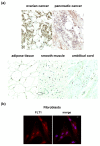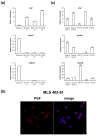Nuclear expression of FLT1 and its ligand PGF in FUS-DDIT3 carrying myxoid liposarcomas suggests the existence of an intracrine signaling loop
- PMID: 20515481
- PMCID: PMC2889895
- DOI: 10.1186/1471-2407-10-249
Nuclear expression of FLT1 and its ligand PGF in FUS-DDIT3 carrying myxoid liposarcomas suggests the existence of an intracrine signaling loop
Abstract
Background: The FUS-DDIT3 fusion oncogene encodes an abnormal transcription factor that has a causative role in the development of myxoid/round-cell liposarcomas (MLS/RCLS). We have previously identified FLT1 (VEGFR1) as a candidate downstream target gene of FUS-DDIT3. The aim of this study was to investigate expression of FLT1 and its ligands in MLS cells.
Methods: HT1080 human fibrosarcoma cells were transiently transfected with FUS-DDIT3-GFP variant constructs and FLT1 expression was measured by quantitative real-time PCR. In addition, FLT1, PGF, VEGFA and VEGFB expression was measured in MLS/RCLS cell lines, MLS/RCLS tumors and in normal adiopocytes. We analyzed nine cases of MLS/RCLS and one cell line xenografted in mice for FLT1 protein expression using immunohistochemistry. MLS/RCLS cell lines were also analyzed for FLT1 by immunofluorescence and western blot. MLS/RCLS cell lines were additionally treated with FLT1 tyrosine kinase inhibitors and assayed for alterations in proliferation rate.
Results: FLT1 expression was dramatically increased in transfected cells stably expressing FUS-DDIT3 and present at high levels in cell lines derived from MLS. The FLT1 protein showed a strong nuclear expression in cells of MLS tissue as well as in cultured MLS cells, which was confirmed by cellular fractionation. Tissue array analysis showed a nuclear expression of the FLT1 protein also in several other tumor and normal cell types including normal adipocytes. The FLT1 ligand coding gene PGF was highly expressed in cultured MLS cells compared to normal adipocytes while the other ligand genes VEGFA and VEGFB were expressed to lower levels. A more heterogeneous expression pattern of these genes were observed in tumor samples. No changes in proliferation rate of MLS cells were detected at concentrations for which the kinase inhibitors have shown specific inhibition of FLT1.
Conclusions: Our results imply that FLT1 is induced as an indirect downstream effect of FUS-DDIT3 expression in MLS. This could be a consequence of the ability of FUS-DDIT3 to hijack parts of normal adipose tissue development and reprogram primary cells to a liposarcoma-like phenotype. The findings of nuclear FLT1 protein and expression of corresponding ligands in MLS and normal tissues may have implications for tissue homeostasis and tumor development through auto- or intracrine signaling.
Figures





Similar articles
-
The myxoid/round cell liposarcoma fusion oncogene FUS-DDIT3 and the normal DDIT3 induce a liposarcoma phenotype in transfected human fibrosarcoma cells.Am J Pathol. 2006 May;168(5):1642-53. doi: 10.2353/ajpath.2006.050872. Am J Pathol. 2006. PMID: 16651630 Free PMC article.
-
The myxoid liposarcoma FUS-DDIT3 fusion oncoprotein deregulates NF-kappaB target genes by interaction with NFKBIZ.Oncogene. 2009 Jan 15;28(2):270-8. doi: 10.1038/onc.2008.378. Epub 2008 Oct 13. Oncogene. 2009. PMID: 18850010
-
Deciphering the role of FUS::DDIT3 expression and tumor microenvironment in myxoid liposarcoma development.J Transl Med. 2024 Apr 26;22(1):389. doi: 10.1186/s12967-024-05211-w. J Transl Med. 2024. PMID: 38671504 Free PMC article.
-
FUS::DDIT3 Fusion Protein in the Development of Myxoid Liposarcoma and Possible Implications for Therapy.Biomolecules. 2024 Oct 14;14(10):1297. doi: 10.3390/biom14101297. Biomolecules. 2024. PMID: 39456230 Free PMC article. Review.
-
Gene of the month: DDIT3.J Clin Pathol. 2024 Mar 20;77(4):211-216. doi: 10.1136/jcp-2023-208963. J Clin Pathol. 2024. PMID: 38053287 Review.
Cited by
-
Genetic, Epigenetic and Transcriptome Alterations in Liposarcoma for Target Therapy Selection.Cancers (Basel). 2024 Jan 8;16(2):271. doi: 10.3390/cancers16020271. Cancers (Basel). 2024. PMID: 38254762 Free PMC article. Review.
-
Suppression of MKL1 promotes adipocytic differentiation and reduces the proliferation of myxoid liposarcoma cells.Oncol Lett. 2020 Dec;20(6):369. doi: 10.3892/ol.2020.12232. Epub 2020 Oct 19. Oncol Lett. 2020. PMID: 33154767 Free PMC article.
-
A novel oncogenic pathway by TLS-CHOP involving repression of MDA-7/IL-24 expression.Br J Cancer. 2012 Jun 5;106(12):1976-9. doi: 10.1038/bjc.2012.199. Epub 2012 May 15. Br J Cancer. 2012. PMID: 22588557 Free PMC article.
-
Liposarcoma: molecular genetics and therapeutics.Sarcoma. 2011;2011:483154. doi: 10.1155/2011/483154. Epub 2010 Dec 27. Sarcoma. 2011. PMID: 21253554 Free PMC article.
-
Axitinib Has Antiangiogenic and Antitumorigenic Activity in Myxoid Liposarcoma.Sarcoma. 2016;2016:3484673. doi: 10.1155/2016/3484673. Epub 2016 Oct 16. Sarcoma. 2016. PMID: 27822137 Free PMC article.
References
-
- Fletcher CDM, Unni KK, Mertens F. World Health Organization Classification of Tumours. Pathology and Genetics of Tumours of Soft Tissue and Bone. IARC Press: Lyon; 2002.
-
- Andersson MK, Stahlberg A, Arvidsson Y, Olofsson A, Semb H, Stenman G, Nilsson O, Aman P. The multifunctional FUS, EWS and TAF15 proto-oncoproteins show cell type-specific expression patterns and involvement in cell spreading and stress response. BMC Cell Biol. 2008;9:37. doi: 10.1186/1471-2121-9-37. - DOI - PMC - PubMed
Publication types
MeSH terms
Substances
LinkOut - more resources
Full Text Sources
Research Materials

